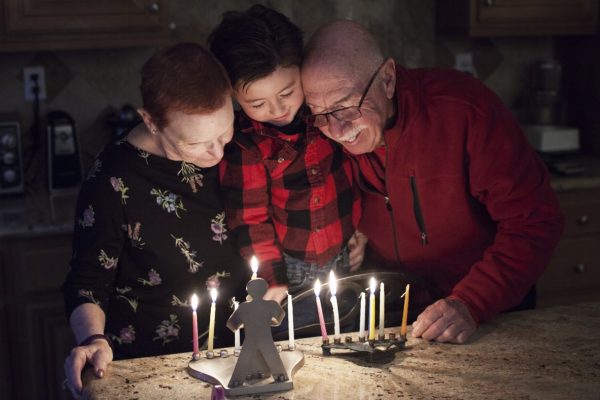Celebrating pregnancy has never been part of Jewish ritual, but rather is a recent custom, practiced only in some Jewish communities. Ethnographers have observed that AshkenaziJew of Eastern European descent. The term also refers to the practices and customs associated with this community, often in contrast to Sephardic (Southern European) traditions. Jews have taken care that a woman’s gravid state should not be noticeable for as long as possible, whereas in the early twentieth century, SephardicJews of Spanish descent; sometimes used to describe Jews of North-African and Middle-Eastern descent. The term also describes the customs and practices of these Jews, often in comparison to those of Ashkenazi (Eastern European) Jews. and some Kurdistani Jews celebrated the prospect of a first birth with a ceremonial preparation of the layette for the newborn.
Ashkenazi Jews in the shtetl believed that proud talk when a pregnancy was barely established would invite catastrophe. Like other Jews, they feared the Evil Eye, expecting it to do harm when their affairs were prospering. Moreover, Hasidic rabbis taught that a man who discovered a new way in which to serve God should keep it secret for nine months, as though he were pregnant with it, and inform others of it only at the end of that time, like a birth. Ashkenazi Jews today usually buy nothing for an expected baby until after the birth.
In contrast, Sephardic Jews have often celebrated a first pregnancy. This celebration has been named kortadura de fashadura (in Judeo-Spanish) or tekti’a el-g’daouere (in Judeo-Arabic), meaning “the cutting of the swaddling clothes.” The ceremonial cutting of a cloth to make the baby’s first costume, which is the same for a girl or a boy, is an old Sephardic custom still continued by some Jews in Istanbul. When a Jewish woman reaches the fifth month of her first pregnancy, her family invites all her female relatives and in-laws, as well as friends and neighbors. Liqueurs and chocolates, tea, cakes and sugared almonds are set out on the best china, on hand embroidered tablecloths. The cloth is of excellent quality and traditionally comes from the expectant woman’s dowry. A relative who is herself a mother and whose own parents are still alive (a good omen for long life) receives the honor of making the first cut in the cloth. At the moment of the cut, the pregnant woman throws white sugared almonds on the cloth, to symbolize the sweet and prosperous future she wishes for her child.
Sephardic Jews in Algeria and Morocco celebrated the cutting of the first layette when a woman was in the last trimester of her first pregnancy. The pregnant woman’s parents provided lengths of cloth on a copper tray covered with a silk scarf. In Algeria, the person who made the first cut was similarly a woman whose parents were still alive and who clearly lived in a happy home. In Morocco, the midwife cut the cloth into swaddling clothes in the presence of women friends and relatives who offered their good wishes and shared tea and cakes. Apparently, this was a very festive occasion, for in 1904 the rabbi of Sefrou decreed against the ostentation displayed at these celebrations. When conception followed a period of barrenness that had been cured by a pilgrimage to the tomb of a famous rabbi, the pregnant woman returned to the tomb for a celebration of cakes and arrack, and she distributed charity to yeshivaSchool of traditional Jewish study. Although historically only for men, today there are some yeshivot (plural) that are for women, and there are progressive yeshivot which are coed. students and the poor. By the middle of the twentieth century, a few Jewish families still continued these traditions, fearing bad luck if, by abandoning them, they omitted the blessings and good wishes for the future child.
In the Holy Land, during the last decades of the Ottoman Empire, Sephardic Jews prepared baby clothes during the last two months of a woman’s pregnancy; but there appears to be no record of a celebration or ceremony. In one account, women sewed the layette from old pieces of cloth, with the most effort put into the baby’s bonnet, the only item that would be visible above layers of swaddling and blanketing. Women decorated the bonnet with colored ribbons and a little sprig of rue against the Evil Eye.
Jewish women in Amadiya, Kurdistan, in the early twentieth century, also celebrated a first pregnancy. When a young woman was certain that she had conceived, she went to her father’s house, where her mother and female relatives sewed clothes for the expected baby. They bestowed the honor of making the sheets for the cradle on an old woman who had delivered many babies. The women invited musicians, sang and danced, and offered the mother-to-be tidbits of advice about childbearing. In the evening, they prepared a feast for the men in the husband’s house. These Jews may have learned this custom of celebrating “the joy of pregnancy” (known as parhiya semaha) from their local neighbors, because elsewhere in Kurdistan, Jews kept the first pregnancy secret as long as possible.
Jews in Yemen and Aden prepared clothes for the newborn in the seventh month of a woman’s pregnancy, but without ceremony. It was customary to conceal pregnancy from the public eye for as long as possible and each woman sewed what she would need for her own baby. When a woman realized that she was pregnant, she shared her knowledge with her mother: “Oh mother, we have sown a generation!” This expression received the standard reply: “Oh daughter, the tidings will come at the hour of birth.”
From “A Time to be Born,” 1998, by the Jewish Publication Society. Used with permission.












